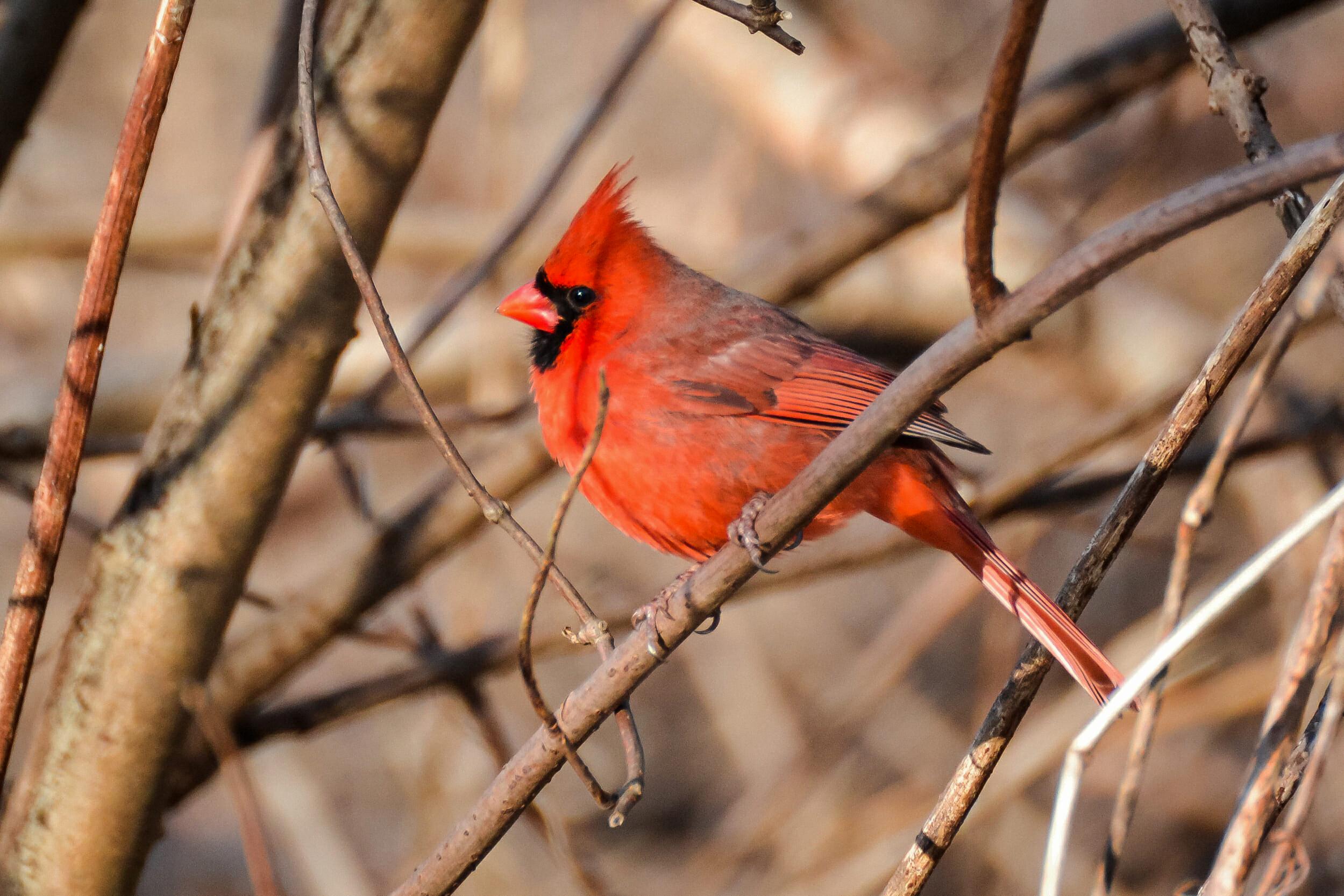Cardinals are beautiful birds known for their vibrant red plumage and melodious songs. While they are a common sight in many backyards, there is often curiosity about their nesting habits and when they lay eggs. In this article, we will explore the fascinating world of cardinals and shed light on the timing of their egg-laying process.
Cardinals, scientifically known as Cardinalis cardinalis, are found throughout North and Central America. These birds typically breed between March and September, although the exact timing can vary depending on geographical location and climate. In warmer regions, cardinals may start breeding as early as February.
When it comes to nest-building, the female cardinal takes the lead. She constructs the nest using twigs, grass, leaves, and other plant materials. The nests are typically built in live trees, shrubs, or vine tangles, anywhere up to about 15 feet high. The height and dense placement of the nests offer some protection against predators.
Interestingly, cardinals are not known to reuse their nests. Each breeding season, the female cardinal builds a new nest from scratch. This behavior ensures that the nest remains clean and reduces the risk of parasites or diseases affecting the eggs or nestlings. The male cardinal assists the female by bringing nesting materials to her, but she does most of the building.
Cardinals typically lay 2-5 eggs in each clutch. The eggs are small, measuring between 0.9-1.1 inches (2.2-2.7 cm) in length and 0.7-0.8 inches (1.7-2 cm) in width. The female incubates the eggs for approximately 11-13 days, keeping them warm and protected until they hatch. During this incubation period, the male cardinal provides food for the female, ensuring she has the energy to fulfill her maternal duties.
Once the eggs hatch, the female continues to care for the nestlings while the male assists with feeding. The nestlings remain in the nest for about 7-13 days, depending on their development. During this time, both parents work tirelessly to provide food for their hungry brood. The diet of cardinals mainly consists of seeds, fruits, and insects.
It is important to note that while cardinals typically follow this breeding pattern, variations can occur. Factors like climate, availability of food, and nest predation can influence their nesting behavior. Nevertheless, the information provided here offers a general understanding of when cardinals lay eggs and how they care for their young.
Cardinals are fascinating birds that bring joy and beauty to our yards. Their breeding season spans from March to September, and the female constructs a new nest for each clutch of 2-5 eggs. The eggs are incubated for about 11-13 days, and the nestlings remain in the nest for 7-13 days. Observing the nesting habits of cardinals can provide a deeper appreciation for these remarkable creatures and their dedication to raising their young.
How Long Do Baby Cardinals Stay In Nest?
Baby cardinals, also known as nestlings, typically stay in the nest for a period of 7-13 days. During this time, they are dependent on their parents for food and care. The exact duration can vary depending on factors such as weather conditions and food availability. It is important for the nestlings to develop their strength and coordination before they fledge, or leave the nest. Once they are ready, they will take their first flight and begin exploring the world outside the nest.

Do Cardinals Use The Same Nest Twice?
Cardinals, although they may nest multiple times in a single breeding season, typically do not reuse their nests. The female cardinal, known for her nest-building skills, constructs a new nest for each breeding attempt. This behavior is observed consistently among cardinals and is believed to serve various purposes, including ensuring the cleanliness and structural integrity of the nest.
Here are a few key points to elaborate on this topic:
1. Nest-building behavior: The female cardinal takes the primary responsibility of constructing the nest, while the male assists in gathering materials. This process involves selecting a suitable location, such as dense shrubs or trees, and building a cup-shaped structure using twigs, grass, leaves, and other plant materials.
2. Nest location: Cardinals tend to build their nests within dense vegetation, which provides protection from predators and shelter from the elements. The specific location may vary, but it is typically around 3-10 feet above the ground.
3. Nest architecture: Cardinals’ nests are known for their sturdy construction. The female weaves together the selected materials, creating a well-insulated cup-shaped nest with a soft inner lining made of grass, leaves, and sometimes feathers. This structure provides a secure environment for incubating eggs and raising chicks.
4. Nest reuse avoidance: Unlike some bird species, cardinals exhibit a strong preference for building new nests for each breeding attempt. This behavior may be attributed to several factors, including hygiene and nest quality. Reusing a nest could potentially expose the new clutch of eggs or hatchlings to parasites, diseases, or structural weaknesses.
5. Factors influencing nest-building: The decision to build a new nest for each breeding attempt may also be influenced by the availability and quality of nesting materials in the vicinity. If sufficient nesting materials are readily available, the female cardinal is more likely to construct a new nest rather than reuse an old one.
Cardinals generally do not reuse their nests and instead build new ones for each breeding attempt. This behavior ensures the cleanliness, structural integrity, and overall suitability of the nest for incubating eggs and raising chicks.
What Does It Mean When Cardinals Nest In Your Yard?
When cardinals nest in your yard, it can hold various meanings and interpretations. Here are a few possible explanations:
1. Symbol of loved ones: In folklore and spiritual beliefs, cardinals are often associated with loved ones who have passed away. Some people believe that when a cardinal visits or nests in your yard, it is a sign that a deceased loved one is watching over you and sending their love and guidance from heaven.
2. Spiritual messenger: Cardinals are known for their vibrant red color, which symbolizes passion, vitality, and energy. Some interpret the presence of cardinals in their yard as a message from the spiritual realm, reminding them to embrace their own inner strength and follow their passions in life.
3. Connection with nature: Cardinals are beautiful birds that are attracted to well-maintained, peaceful environments. If cardinals nest in your yard, it could be a sign that your yard provides a safe and nurturing habitat for these birds. It may indicate that you have created a harmonious and inviting space within nature.
4. Sign of good luck: In some cultures, cardinals are considered a symbol of good luck and prosperity. The sighting of a cardinal or their decision to nest in your yard could be seen as a positive omen, bringing blessings and abundance into your life.
5. Reminder of the present moment: Cardinals are often associated with mindfulness and being present in the moment. Their bright red color and melodious songs can serve as a reminder to stay grounded and appreciate the beauty of the present moment.
Please note that these interpretations are based on folklore, spiritual beliefs, and personal experiences. The meaning of cardinals nesting in your yard can vary for each individual, and it is important to trust your own intuition and beliefs when interpreting such signs.
Where Do Cardinals Lay Their Eggs?
Cardinals lay their eggs in nests that are typically built in live trees, shrubs, or vine tangles. These nests are usually situated at a height of up to about 15 feet above the ground. The cardinals show a preference for higher nests, as well as nests located in denser tangles, as these locations provide some level of protection against potential predators.
The nest-building process is a joint effort between the male and female cardinals. The male bird assists by carrying nesting materials to the female, who takes on the primary responsibility of constructing the nest. This division of labor allows the female to focus on building a safe and suitable nest for their eggs.
By choosing live trees, shrubs, or vine tangles as their nesting sites, cardinals take advantage of the natural structures and foliage that provide a secure environment. These locations offer protection and concealment, making it harder for predators to access the nest and harm the eggs or nestlings.
Cardinals lay their eggs in nests constructed in live trees, shrubs, or vine tangles. They prefer higher nests and denser tangles to decrease the risk of predation. The male assists the female in the nest-building process by providing nesting materials, while the female takes the lead in constructing the nest.

Conclusion
Cardinals are fascinating birds known for their vibrant red plumage and melodious songs. They are found primarily in North America and are a common sight in backyards and gardens. Cardinals are monogamous birds, forming strong pair bonds that can last a lifetime.
One of the most interesting aspects of Cardinals is their nesting behavior. The female Cardinal is responsible for building the nest, which is usually constructed in live trees, shrubs, or vine tangles. They prefer higher nests and denser tangles to provide some protection from predators. Cardinals typically do not reuse their nests, and the female builds a new nest for each breeding season.
Cardinals have a clutch size of 2-5 eggs, which are small in size, measuring around 0.9-1.1 inches in length and 0.7-0.8 inches in width. The incubation period lasts for about 11-13 days, and both the male and female take turns incubating the eggs. Once the eggs hatch, the nestlings remain in the nest for 7-13 days before they are ready to fledge.
There is a popular folklore belief that when a cardinal appears in your yard, it is a visitor from heaven. While this may be a sentimental notion, Cardinals certainly bring joy and beauty to any backyard they visit. Their vibrant red plumage and cheerful songs are a delight to observe and listen to.
Cardinals are remarkable birds with unique nesting habits and striking appearance. Whether they are considered as messengers from heaven or simply cherished backyard visitors, these birds are truly a treasure to behold.
